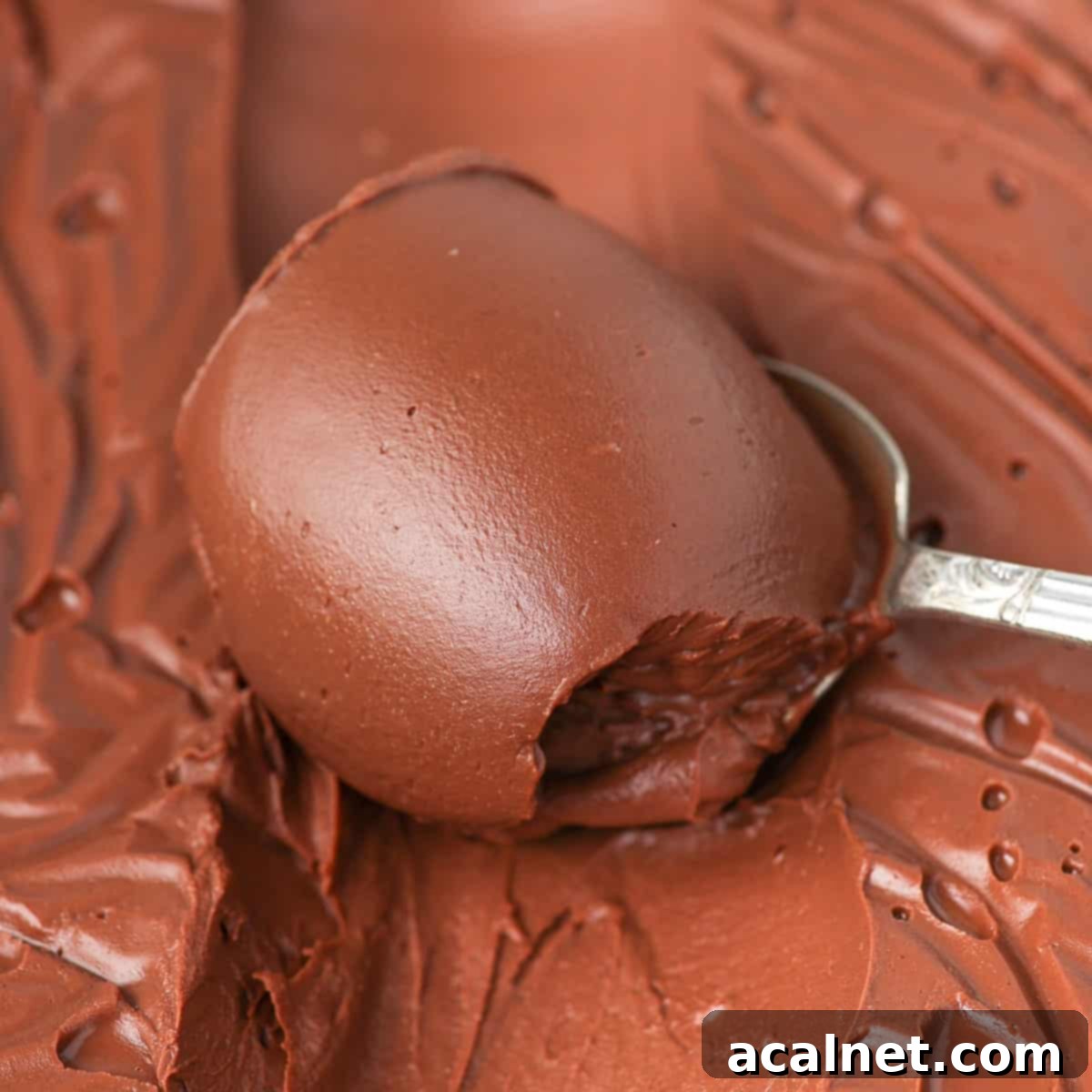Indulge in French Luxury: The Ultimate Silky Dark Chocolate Crémeux (Crémeux au Chocolat) Recipe
Welcome to the world of classic French patisserie, where simple ingredients transform into exquisite delights. This Dark Chocolate Crémeux, known in France as Crémeux au Chocolat, is a testament to that elegance. It’s a luxurious, intensely chocolatey cream with an incredibly smooth, melt-in-your-mouth texture that redefines decadence. Far from just a dessert on its own, its versatility makes it an indispensable component for elevating your favorite cakes, pastries, tarts, and entremets. Prepare to impress with this sophisticated yet surprisingly approachable recipe that captures the essence of French culinary artistry.
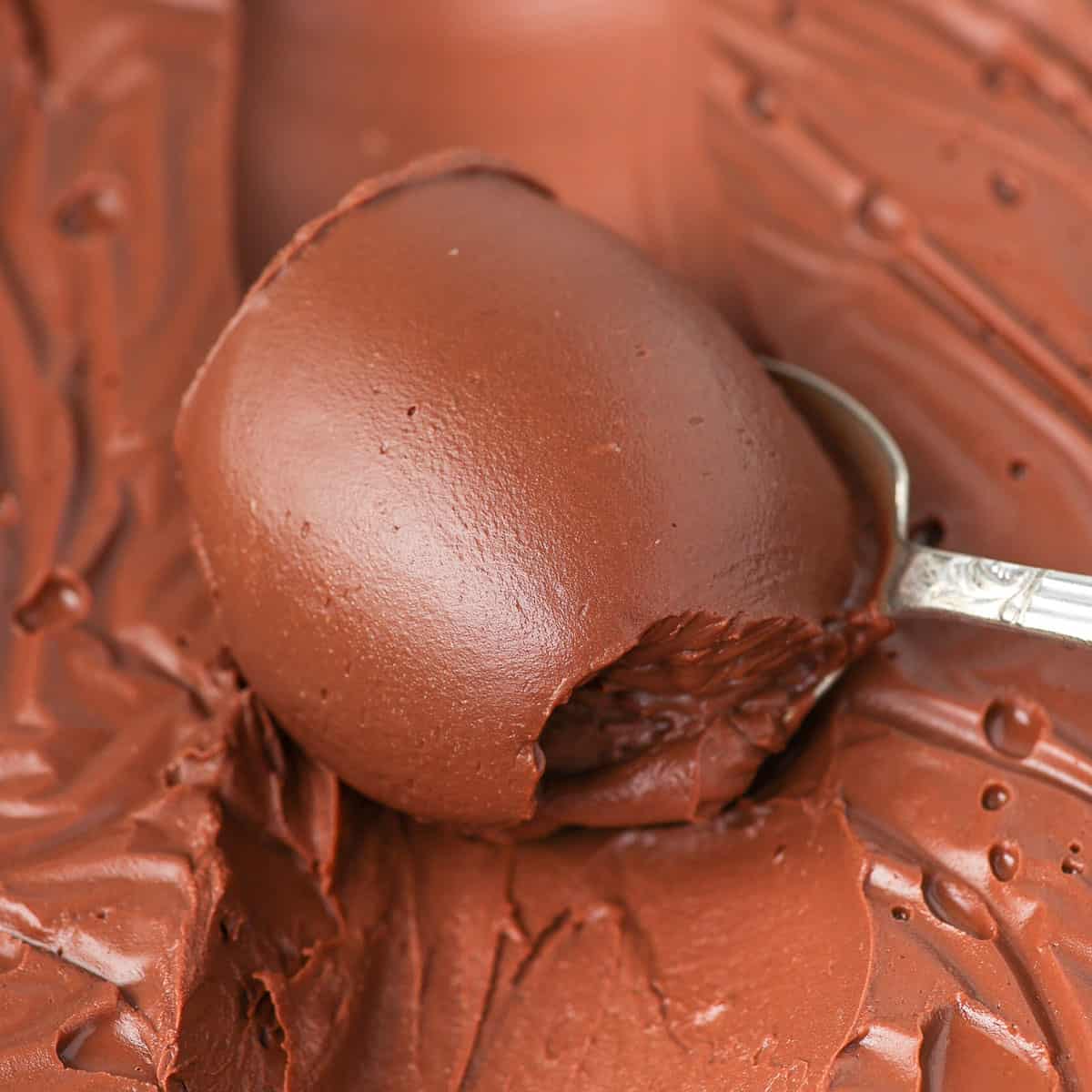
Why You’ll Fall in Love with This Dark Chocolate Crémeux
There’s simply no chocolate cream or frosting that embodies decadence quite like this Dark Chocolate Crémeux. Its exquisitely soft, smooth, and creamy texture is a pure delight, delivering the most intense and authentic chocolate flavor imaginable. What makes this recipe truly special is its simplicity and adaptability. Crafted from just five essential ingredients, it stands out for requiring no butter, offering a fantastic dairy-free option (with appropriate substitutions), and needing only a minimal amount of added sugar to let the rich chocolate shine.
Much like a versatile Chocolate Pastry Cream, elegant Namelaka, light Chocolate Whipped Cream, or robust Whipped Ganache Frosting, this Dark Chocolate Crémeux boasts an impressive array of uses. Imagine it as a luxurious filling for a multi-layered cake or entremet, a rich component within a delicate tart shell, or piped into airy choux pastry. It also serves as a sophisticated topping for your favorite cupcakes and desserts. Beyond all these applications, it’s undeniably magnificent when served simply on its own, perhaps in a small ramekin, for an indulgent spoonful of pure chocolate bliss.
What Exactly is a Crémeux? Unveiling a French Classic
The term “Crémeux” literally translates to “creamy” in French, and this name perfectly encapsulates the essence of this delightful preparation. A chocolate crémeux is a revered classic in French patisserie, celebrated for its uniquely smooth and luscious texture. At its heart, it’s a sophisticated emulsion formed by combining a traditional Crème Anglaise – a rich, pouring custard made with egg yolks, cream, and milk – with high-quality chocolate. Unlike many other crémeux recipes that call for various flavors (such as fruit or coffee) and often require the addition of gelatin to achieve their set texture, a dark chocolate crémeux often sets beautifully on its own. This is thanks to the natural emulsifying properties of egg yolks and the cocoa butter present in dark chocolate, which provides stability as it chills.
The beauty of a crémeux lies in its delicate balance: it’s stable enough to be elegantly piped for decoration, yet exquisitely soft and yielding, making it ideal as a sumptuous filling or a stand-alone dessert. It offers a distinct textural experience, falling somewhere between a firm ganache and a light mousse, distinguished by its pure, unadulterated creaminess and intense flavor concentration.
Essential Ingredients for Your Perfect Dark Chocolate Crémeux
Crafting an exceptional Dark Chocolate Crémeux begins with selecting the right, high-quality ingredients. Each component plays a crucial role in achieving that signature silky texture and profound chocolate flavor.
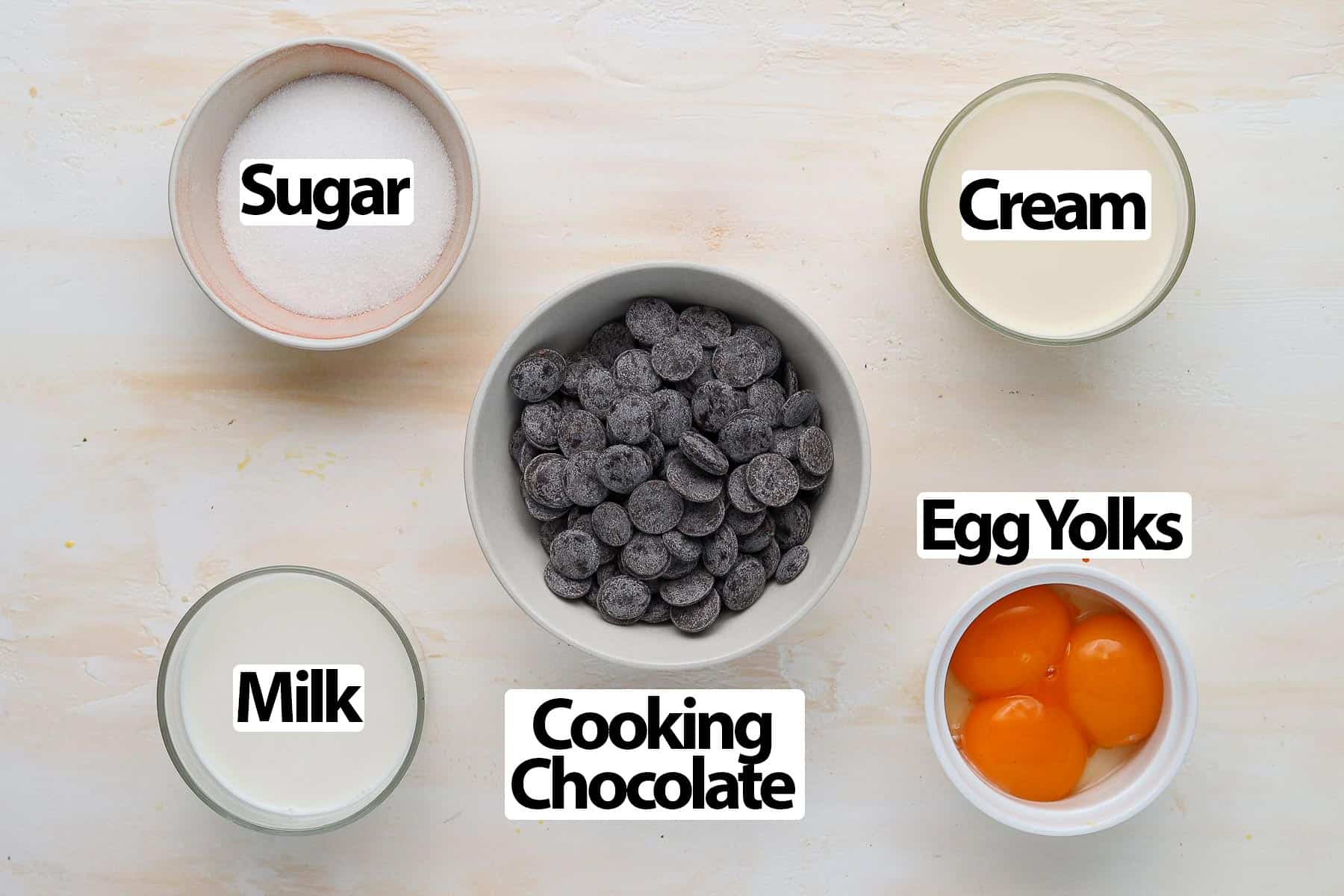
For precise quantities, please refer to the detailed recipe card provided below.
Here’s a closer look at what goes into this exquisite chocolate crémeux:
- Cream + Milk: The foundation of our crémeux, used in a balanced 50/50 ratio. For the most superior flavor and luxurious texture, always opt for full-cream milk (whole milk) and a high-fat thickened or heavy cream (with at least 30% fat content). The fat content is crucial here as it contributes significantly to the richness and creamy mouthfeel of the final product.
- Eggs: Only the vibrant egg yolks are required for this recipe. These yolks are key to creating the Crème Anglaise base, acting as a natural emulsifier and thickener while lending a beautiful richness to the crémeux. Don’t discard the whites! They can be saved for other delightful recipes, such as light and airy Financier Cakes, meringues, or macarons.
- Chocolate: This is where the magic truly happens. A high-quality Dark Cooking Chocolate or Couverture Chocolate is absolutely essential. Aim for chocolate with a cocoa percentage of 70% or higher to achieve that deep, intense chocolate flavor that defines a premium crémeux. Using standard chocolate bars (like candy bars) or chocolate chips, which often contain stabilizers and lower cocoa butter content, can result in a grainy, lumpy, or less stable texture. Invest in good chocolate for a truly professional result.
Thoughtful Substitutions & Flavorful Optional Additions
- Cream and Milk Alternatives: For those seeking a dairy-free option, this recipe can be successfully adapted! Simply swap the dairy cream and milk for plant-based alternatives. The key is to select substitutes that are naturally high in fat, such as full-fat coconut milk (the thick cream from a can, not light versions) or rich oat milk and a plant-based heavy cream substitute. Avoid “light” or “reduced-fat” options, as they will compromise the crémeux’s texture and ability to set.
- Elevate the Flavor Profile: While delicious on its own, you can easily infuse your crémeux with additional layers of flavor. Consider adding a touch of Vanilla (either extract, paste, or a scraped vanilla bean into the heating milk/cream), a pinch of instant Coffee Powder (which beautifully enhances chocolate notes), a subtle hint of Sea Salt to balance the sweetness, bright Orange Zest for a citrusy lift, a spoonful of rich Praline Paste for nutty depth, or even a sophisticated touch of your favorite liquor, such as Grand Marnier, Kahlúa, or rum, to truly make it your own.
Mastering the Art of Crémeux au Chocolat: A Step-by-Step Guide
Making a Dark Chocolate Crémeux might sound intimidating, but it’s a straightforward process that yields incredibly rewarding results. Follow these steps carefully to achieve a flawlessly silky and delicious crémeux every time.
Step 1: Preparing the Crème Anglaise Base
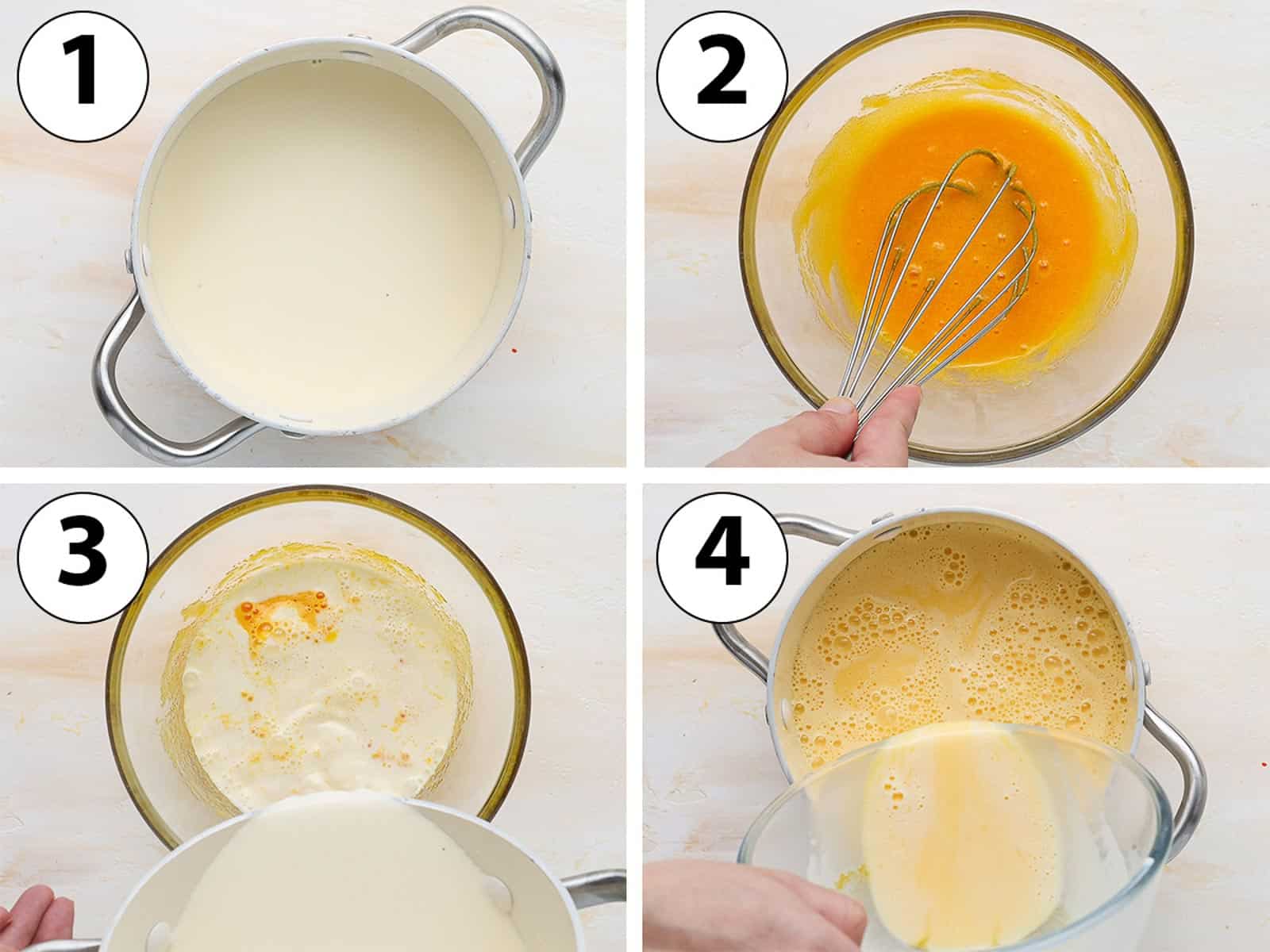
- Photo 1: Begin by combining the Heavy Cream and Whole Milk in a small, sturdy saucepan. Gently heat the mixture over low to medium heat, stirring occasionally, until it just begins to simmer. You’ll see tiny bubbles forming around the edges of the pan. As soon as it reaches this point, promptly remove the saucepan from the heat to prevent it from boiling vigorously, which can scorch the milk. If you’re incorporating vanilla from a fresh bean, now is the time: scrape the seeds into the hot liquid and let it infuse, covered with a lid, for 10-15 minutes off the heat for maximum flavor extraction.
- Photo 2: While the milk and cream are heating, in a separate heat-proof bowl, vigorously whisk together the Egg Yolks and Caster Sugar until the mixture becomes pale and slightly thickened. This process helps to aerate the yolks and sugar, creating a stable base for tempering.
- Photo 3: This is the crucial tempering step. Slowly, and in a thin stream, pour about one-third of the hot milk mixture over the egg and sugar mixture in the bowl, whisking continuously and energetically. This gradual addition and constant whisking gently raises the temperature of the egg yolks, preventing them from scrambling when they are fully combined with the rest of the hot liquid.
- Photo 4: Once tempered, pour the entire egg-milk mixture back into the saucepan. Return the saucepan to the stove over very low to medium-low heat. It’s imperative that the mixture does not come to a boil at this stage, as excessive heat will cause the eggs to curdle, resulting in a grainy texture.
Step 2: Gently Cooking the Crème Anglaise
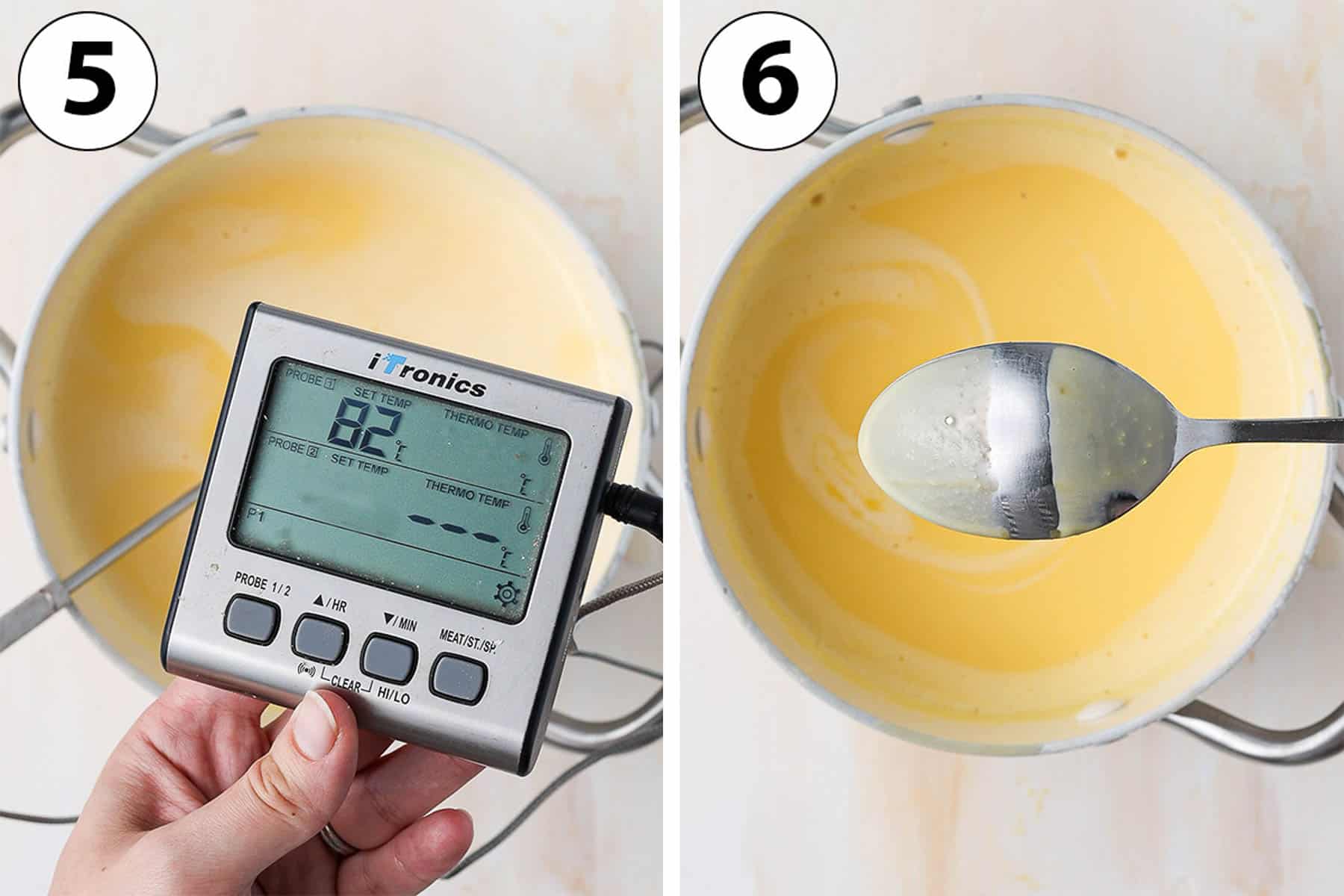
- Continue to cook the custard base over low heat, stirring continuously with a heat-proof spatula or whisk. This process will typically take between 5 to 10 minutes. The key is to stir constantly to prevent the eggs from settling at the bottom and overcooking, which leads to lumps. The custard mixture will gradually thicken to a consistency that coats the back of a spoon. Remember, it should not boil or even vigorously simmer.
There are two reliable methods to accurately determine if your Crème Anglaise is perfectly cooked:
- Photo 5: The most precise method is to use a digital thermometer. The cream must reach a temperature of 82°C to 84°C (180°F to 184°F). This temperature range ensures the eggs are fully cooked and safe to consume, while preventing them from overcooking and coagulating into an undesirable grainy or lumpy texture.
- Photo 6: A traditional and equally effective visual test is to “coat the back of a spoon.” Dip a spoon into the custard, then carefully draw an horizontal line across the back of the spoon with your finger (be cautious, as it will be hot!). If the line holds clear and the custard doesn’t immediately run back into the gap, your custard is perfectly thick and ready. If the cream drips over the line, it needs a little more cooking time.
Once cooked, if you notice any small lumps, pour the custard immediately through a fine-mesh sieve into a clean bowl. This step ensures an ultra-smooth base for your crémeux.
Step 3: Creating the Silky Chocolate Emulsion
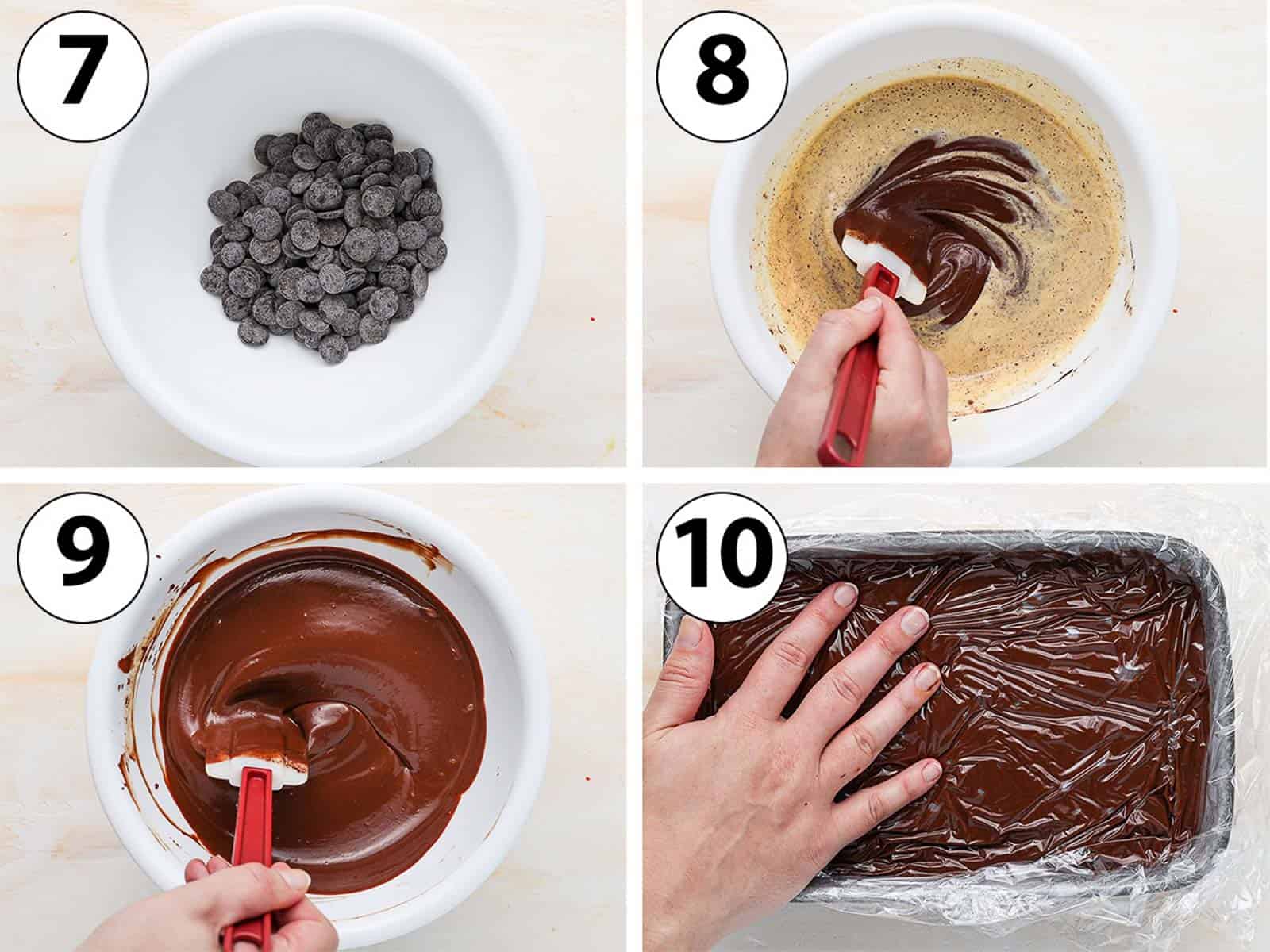
- Photo 7: Prepare your chocolate. If you are using high-quality Callets or Pistoles (small, uniform chunks of couverture chocolate), you can use them as they are. If you’re working with a block or bar of cooking chocolate, ensure it is very finely chopped. Place the prepared chocolate in a clean, heat-proof bowl.
- Carefully pour the hot Crème Anglaise (custard mixture) directly over the chopped chocolate. Resist the urge to stir immediately; instead, let the mixture sit undisturbed for 2 to 3 minutes. This allows the residual heat from the custard to gently melt the chocolate, ensuring an even and smooth process.
- Photo 8: After the resting period, begin to gently stir the mixture with a spatula. Start from the center and move outwards in slow, circular motions. This technique helps to initiate the emulsion, gradually incorporating the melted chocolate into the cream.
- Photo 9: Continue stirring until all the chocolate is fully melted and completely combined with the custard, resulting in a thick, homogenous, and incredibly smooth cream. The mixture should appear glossy and rich.
Alternative Mixing Method: For an even smoother finish and to ensure all chocolate is perfectly melted, pour the hot cream over the chocolate in a tall, narrow container or a measuring jug. After letting it sit for 2-3 minutes, use an immersion blender (stick blender) to gently emulsify the mixture. Blend without lifting the blender head too much to avoid incorporating excessive air bubbles, which can alter the final texture.
Troubleshooting Unmelted Chunks: If you find stubborn chunks of unmelted chocolate, you can gently continue the melting process over a double-boiler (bain-marie). Ensure the heat is very low and stir constantly to prevent the custard from overcooking or splitting.
- Photo 10: Once perfectly smooth, transfer your exquisite chocolate crémeux into a shallow pan or dish. Cover the surface directly with plastic wrap, pressing it down so it touches the crémeux to prevent a skin from forming.
- Place the crémeux in the fridge to set and chill for a minimum of 2 hours, though for the best texture and deepest flavor, it’s highly recommended to chill it overnight.
The serving temperature of your crémeux will influence its consistency. You can use it straight from the fridge for a firmer, more pipeable texture, or allow it to come to a slightly cooler room temperature for a softer, more spoonable dessert.

Frequently Asked Questions About Dark Chocolate Crémeux
For an authentic and superior Dark Chocolate Crémeux, the quality of your chocolate is paramount. Always select a high-quality cooking or couverture chocolate with a high cocoa percentage, ideally 70% or more. Couverture chocolate, specifically designed for melting and tempering, contains a higher proportion of cocoa butter, which contributes to the crémeux’s luxurious texture and smooth melt. Avoid using standard chocolate bars (like candy bars) or chocolate chips, as these often contain lower cocoa butter content and added stabilizers or waxes, which can result in a grainy, less stable, or improperly melted crémeux.
While all are delicious chocolate-based creams, their compositions and textures differ significantly. A Crémeux is a sophisticated emulsion of a rich pouring custard (Crème Anglaise), made primarily with egg yolks, milk, and cream, combined with melted chocolate. This gives it a unique, intensely creamy yet stable texture. A Ganache is typically a simpler preparation, a 50:50 ratio mixture of just chocolate and hot cream (sometimes butter is added). Its texture can range from pourable to firm, depending on the ratio and cooling. Pastry Cream (Crème Pâtissière) is similar to Crème Anglaise but includes a starch (like cornstarch or flour) to make it much thicker and custard-like, making it ideal for filling tarts and éclairs.
The primary distinction lies in their aeration. A crémeux is characterized by its dense, smooth, and creamy consistency, containing no whipped ingredients. It achieves its texture through the emulsification of a custard base and chocolate. In contrast, a Mousse is light and airy, incorporating whipped elements such as whipped cream or whipped egg whites, which introduce air and create its characteristic delicate, foamy structure. While both are incredibly delicious, a crémeux offers a more profound and rich melt-in-your-mouth experience, whereas a mousse is ethereal and delicate.
For a Dark Chocolate Crémeux, the addition of gelatin is generally not required. The high cocoa butter content in quality dark chocolate, combined with the emulsifying properties of the egg yolks in the Crème Anglaise, provides sufficient stability for the crémeux to set beautifully on its own. It will hold its shape very well when chilled and even when piped. However, if you opt to make a crémeux with white chocolate or milk chocolate (which have a lower cocoa butter percentage), you might consider adding a small amount of gelatin to ensure a firm and stable set, as these chocolates are naturally less stable.

Expert Tips & Troubleshooting for Perfect Crémeux
Achieving a perfect crémeux is a rewarding experience, but sometimes challenges arise. Here are some expert tips and solutions to common issues:
- How long does it take to set: Patience is a virtue when making crémeux. While this recipe typically begins to set within at least 2 hours in the fridge, I wholeheartedly recommend allowing it to chill overnight. This extended chilling time isn’t just about setting; it allows the flavors to meld and deepen, resulting in a crémeux with the most exquisite, incredibly smooth, and stable texture that is truly next level.
- The custard base is too liquid: If your Crème Anglaise base remains too thin and runny after cooking, it generally means it hasn’t reached the correct temperature. It absolutely needs to hit 82°C / 180°F to properly cook the egg yolks and achieve the correct consistency. Remember that this custard will be thinner than a pastry cream or traditional pudding, but it should still noticeably coat the back of a spoon. Also, ensure you’re using full-fat (whole) milk and heavy cream; low-fat or light dairy products will not thicken sufficiently.
- The crémeux is grainy or lumpy: This unfortunate outcome usually stems from two main issues: either the egg yolks were cooked too quickly or at too high a temperature (causing them to scramble), or the chocolate was subjected to excessive heat during melting. To remedy this, first, try pouring the warm crémeux through a very fine-mesh sieve to catch any large lumps. For smaller grains, a truly effective solution is to carefully blend the crémeux with an immersion blender on a very low setting. Blend slowly and gently until the mixture is completely smooth and emulsified.
- The cream has split: A split crémeux is a classic sign of a broken emulsion, meaning the fat and liquid components have separated rather than combined harmoniously. This often occurs if the chocolate and custard weren’t at the right temperatures when combined, or if they were stirred too vigorously or not enough. To fix a split crémeux, try whisking it vigorously again in a clean bowl. If it still doesn’t come together, gently warm a small portion of plain cream (about 1-2 tablespoons) and slowly drizzle it into the split crémeux while continuously whisking or blending with an immersion blender until it re-emulsifies into a smooth consistency.
- The cream won’t set: A crémeux that fails to set almost always needs more time to chill. Given the natural setting properties of cocoa butter in quality dark chocolate and the egg yolks, there’s rarely a fundamental reason for it not to set, assuming the correct quantities of ingredients (especially chocolate) were used. Double-check your measurements and ensure you used a proper cooking or couverture dark chocolate. If all else fails, extend the chilling time in the coldest part of your refrigerator.
- The chocolate crémeux is too runny: This issue is typically a combination of factors: the custard base might not have been cooked sufficiently to its thickening point, or the crémeux wasn’t chilled for an adequate amount of time. It’s also crucial to note that this specific recipe is developed for Dark Chocolate. Milk chocolate and white chocolate contain significantly different amounts of cocoa butter, which directly impacts their setting ability and final consistency. Using these lighter chocolates without adjusting the recipe (e.g., adding gelatin) will likely result in a much runnier crémeux.
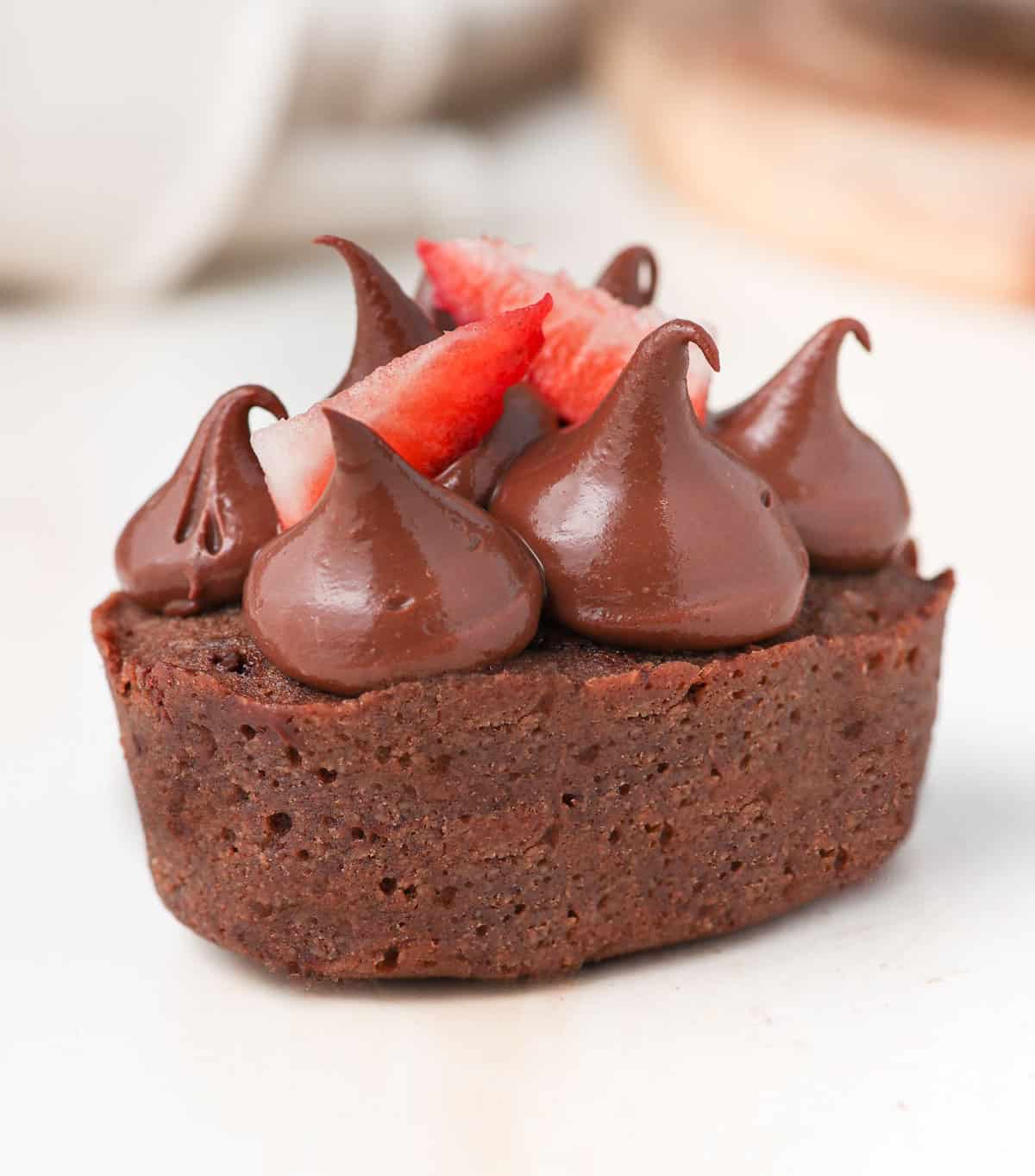
Creative Ways to Utilize This Decadent Chocolate Crémeux
The beauty of this Dark Chocolate Crémeux lies in its incredible versatility. Its rich flavor and elegant texture make it suitable for a myriad of applications, transforming ordinary desserts into extraordinary experiences:
- As a Luxurious Tart Filling: This crémeux is an ideal filling for a variety of tarts. Pipe it into a crisp Pâte Sablée (French Shortcrust Pastry), a rich Chocolate Pie Crust, or small Mini Tart Shells. It creates a beautiful contrast with fruit toppings or a dusting of cocoa powder.
- Layered in Cakes and Entremets: Elevate your layered cakes or intricate entremets by using this crémeux between sponge layers, such as a delicate Dacquoise Sponge. Its smooth texture provides a delightful counterpoint to other components like mousses, fruit inserts, or crunch layers.
- Elegant Decoration for Pastries: With its stable yet creamy consistency, this chocolate crémeux can be piped beautifully to decorate cakes, cupcakes, or individual pastries. Think of it as a sophisticated alternative to buttercream or standard frostings, offering a more intense chocolate experience. For example, it makes a divine topping for Chocolate Financiers, adding a touch of gourmet flair.
- A Stand-Alone Dessert Experience: Sometimes, simplicity is key. This chocolate crémeux is so rich and flavorful that it shines brightly as a dessert on its own. Serve it chilled in elegant glasses or small cups, perhaps garnished with a dollop of freshly whipped cream, a sprinkle of flaky sea salt, or accompanied by some complementary poached fruits like tender Stewed Pears.
Storing Your Dark Chocolate Crémeux: Freshness & Texture
To best preserve its luxurious texture and intense flavor, this Dark Chocolate Crémeux is best enjoyed within 3 days of preparation. It should always be stored in the refrigerator in an airtight container. If using a bowl, ensure it’s tightly covered with plastic wrap, pressing the wrap directly onto the surface of the crémeux to prevent any air exposure, which can cause a skin to form and dry out the cream.
While some creams can tolerate freezing, I generally do not recommend freezing this chocolate crémeux on its own. Freezing and thawing can significantly affect its delicate, silky smooth texture, potentially making it grainy or watery. The only exception is if the crémeux is incorporated into a larger dessert, such as a cake or entremet, which is designed to be frozen to set its structure. In such cases, the overall composition helps to maintain the crémeux’s integrity.

Explore More Decadent Cream Recipes
If you’ve enjoyed mastering this Dark Chocolate Crémeux, you might be interested in expanding your repertoire of exquisite cream recipes. Each offers unique textures and flavors perfect for various patisserie applications:
- Rich Chocolate Pastry Cream
- Classic Vanilla Crème Pâtissière
- Bright & Tangy Lemon Curd
- Light & Fluffy Whipped Ganache Frosting
- Exotic Passion Fruit Curd
- Nutty Almond Cream Filling (Frangipane)
- Delicate Diplomat Cream (Crème Diplomate)
- Fragrant Orange Curd
- Smooth Bavarian Cream (Crème Bavaroise)
- Velvety Namelaka
I am so excited to share that my debut cookbook
“Bite-Sized French Pastries for the Beginner Baker”
is now available for purchase!
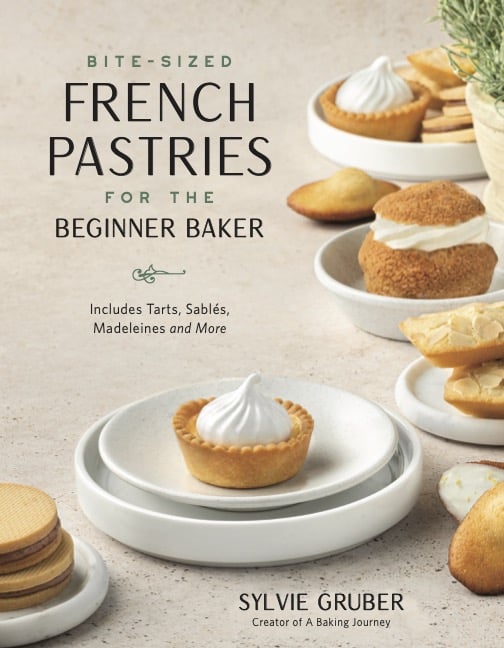
Full Recipe: Classic Dark Chocolate Crémeux (Crémeux au Chocolat)
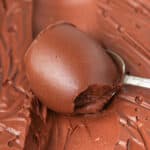
Chocolate Crémeux (Crémeux au Chocolat)
Servings:
550
grams of cream (approx).
Author:
Sylvie
15 minutes
2 hours
2 hours
15 minutes
Print Recipe
Prevent your screen from going dark
Ingredients
-
150
ml
Heavy / Thickened Cream -
150
ml
Full Cream / Whole Milk -
3
Egg Yolks,
(approximately 60 grams) -
50
gr
Caster Sugar -
150
gr
Dark Cooking Chocolate,
(or high-quality Couverture Chocolate, at least 70% cocoa)
Instructions
- Combine the Heavy Cream and Whole Milk in a small saucepan. Heat over low to medium-low heat until it just begins to simmer, then immediately remove from the stove.
- In a separate heat-proof bowl, whisk together the Egg Yolks and Caster Sugar until the mixture is pale and slightly thickened.
- Slowly pour about one-third of the hot milk/cream mixture over the egg yolk and sugar, whisking continuously to temper the eggs (see note 1). Pour the entire mixture back into the saucepan and place it back on the stove over low heat, ensuring it does not boil.
- Continuously stir the custard on low heat for 5 to 10 minutes, or until the mixture has slightly thickened and coats the back of a spoon (see note 2). It should reach 82-84°C (180-184°F).
- Place the finely chopped Dark Cooking Chocolate (or Callets/Pistoles) in a heat-proof bowl. Pour the warm, cooked custard directly over the chocolate. Let it sit undisturbed for 2 to 3 minutes to allow the chocolate to melt. Then, using a spatula, gently stir in circular motions from the center outwards until all the chocolate is melted and you have a smooth, glossy cream (see note 3).
- Transfer the chocolate crémeux into a shallow pan or dish and cover its surface directly with plastic wrap to prevent a skin from forming. Place in the refrigerator to chill and set for at least 2 hours, or preferably overnight, for the best texture and flavor. Use within 3 days.
Video Tutorial
Would you like to save this recipe?
We’ll email this post to you, so you can come back to it later!
Notes
(2) To check if your custard is perfectly cooked:
- Thermometer method: The custard should reach a temperature between 82°C and 84°C (180°F to 184°F). Do not exceed this range to avoid overcooking the eggs.
- Spoon test: Dip a spoon into the custard, then carefully run your finger across the back of the spoon. If the line remains clear and the custard doesn’t immediately flow back into the gap, it’s thick enough and ready. If it drips over the line, continue cooking for a minute or two longer.
(3) For an exceptionally smooth crémeux, after pouring the hot cream over the chocolate and letting it rest, you can use an immersion blender. Blend the mixture in a narrow container or measuring jug, keeping the blender head submerged and avoiding excessive up-and-down movements to minimize air bubbles. This ensures a perfect emulsion.
Nutrition (per serving)
